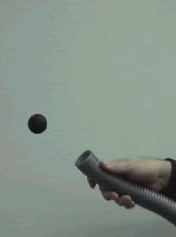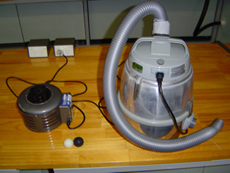Floating Ball | Pōro Rewa
Introduction
Abstract
A ball is suspended in an upward column of air and prevented from moving sideways by the reduced pressure near the centre of the flow.
Principles Illustrated
Fluid flow and Bernoulli’s Principle. See discussion below.
Content
Video
English version
Te Reo Māori Version
Instructions
A blower is used to “levitate” a ball as shown in the video. This is very easy to do with a bit of practice if you have an adjustable flow blower. The key is adjusting the airflow. Start with a relatively low airflow and increase gradually. Heavier balls such as a squash ball will require much more airflow. If necessary the airflow can be adjusted by bending the hose.
With more practice it is possible to get two or sometimes even three balls to “levitate” in the air stream, in a vertical column. They will occasionally flip places, a very interesting phenomenon. It takes a few trials and the right air flow to get the demonstration going with multiple balls but it is impressive and worth the effort.




Other Information
Safety
The airflow can contain dust and particles. Do not let students point it at a person’s face.
Individual teachers are responsible for safety in their own classes. Even familiar demonstrations should be practised and safety-checked by individual teachers before they are used in a classroom.
Related Resources
Bernoulli Tubes, Pōro me te Ipuroa Wahanui (Bernoulli Funnel), and Ngā Perēti a Bernoulli (Bernoulli Plates)
Notes, Applications, and Further Reading
Bernoulli’s principle tells us that the pressure is lowest in a fluid where the fluid is moving fastest (for points at the same height). This is reflected in Bernoulli’s equation for an incompressible fluid.

Here we have a blower producing a fast-moving column of air. Pressure in the fast-moving air column is lower that in the slow-moving surroundings. The ball is trapped in the high speed, low pressure stream. The Bernoulli equation is exact only under restricted conditions and will apply only approximately to air flow in these experiments.
This demonstration is related to PIRA 2C20.30.
Credits
This teaching resource was developed by the Te Reo Māori Physics Project with support from
- Te Puni Kōkiri
- The MacDiarmid Institute
- Faculty of Science, Victoria University of Wellington
- School of Chemical and Physical Sciences, Victoria University of Wellington
- The New Zealand map shown on the poster frame above is used with permission from www.nz.com.